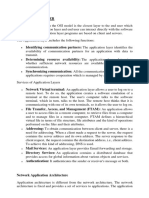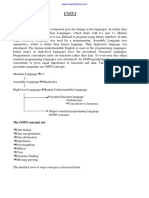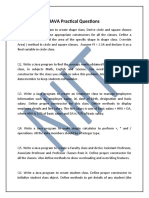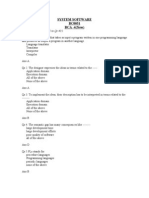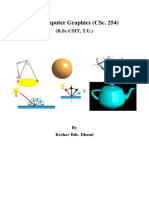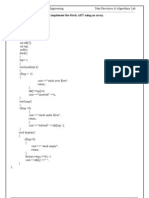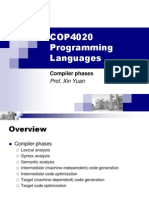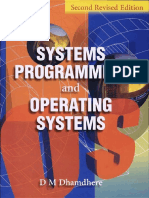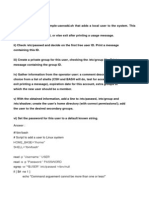0 ratings0% found this document useful (0 votes)
1K views456 pagesSystem Software PDF
Uploaded by
Nasir MasoodCopyright
© © All Rights Reserved
We take content rights seriously. If you suspect this is your content, claim it here.
Available Formats
Download as PDF or read online on Scribd
0 ratings0% found this document useful (0 votes)
1K views456 pagesSystem Software PDF
Uploaded by
Nasir MasoodCopyright
© © All Rights Reserved
We take content rights seriously. If you suspect this is your content, claim it here.
Available Formats
Download as PDF or read online on Scribd
You are on page 1/ 456
SYSTEMS
PROGRAMMING
D M Dhamdhere
&§ Tata McGraw-Hill
Published by Tata McGraw Hill Education Private Limited,
7 West Patel Nagar, New Delhi 110 008
Systems Programming
Copyright © 2011 by Tata McGraw Hill Education Private Limited.
First reprint 2011
RBZCRRBGRCQQZ
No part of this publication may be reproduced or distributed in any form or by any means, electronic, mechanical,
photocopying, recording, or otherwise orstored in a database or retrieval system without the prior written permission
of the publishers, The program listings (if any) may be entered, siored and executed in a computer system, but they
may not be reproduced for publication.
This edition can be exported from India only by the publishers,
Tata McGraw Hill Education Private Limited.
ISBN (13): 978-0-07-133311-5
ISBN (10): 0-07-133311-8
Vice President and Managing Direcior—McGraw-Hill Education, Asia Pacific Region: Afay Shukla
Head—Higher Education Publishing and Marketing: Vibha Mahajan
Publishing Manager—SEM & Tech Ed.: Shalini Jha
Editorial Researcher: Noaman Khan
Sr Copy Editor: Nimisha Kapoor
Sr Production Manager: Satinder S Baveja
Marketing Manager—Higher Education: Vijay S Jagannathan
Sr Product Specialist SEM & Tech Ed.: John Mathews
General Manager—Production: Rajender P Ghansela
‘Asst General Manager—Production: BL Dogra
reliable. However, neither Tata McGraw-Hill nor its authors guarantee the accuracy or completeness of
any information published herein, and neither Tata McGraw-Hill nor its authors shall be responsible for
any errors, omissions, or damages arising out of use of this information, This work is published with the
understanding that Tata McGraw-Hill and its authors ere supplying information but are not attempting
to render engineering or other professional services. If such services are required, the assistance of an
appropriate professional should be sought.
[ Information contained in this work has been obtained by Teta McGraw-Hill, from sources believed to be
‘Typeset at Script Makers, 19, Al-B, DDA Market, Paschim Vihar, New Delhi 110 063 and text printed at Adarsh
Printers, C-50-51, Mohan Park, Naveen Shahdara, Delhi — 110032
Cover Designer: Meenu Raghav
Cover Printer: A. B. Offset
ac a
Contents
Preface
L_introduction
1.1 What is System Software?
1.2 Goals of System Software
all
1.3 System Programs and Systems Programming g
1.4 The Wonderland of System Software 8g
1.4.1 The Program Development and Production Environments 9
1.4.2 Making Software Portable ir
1.43 Realizing Benefits of the Internet 12
1.4.4 Treating Programs as Components 13
14.5 Quick-and-Dirty Programming 14
1.4.6 The Embedded System Environment 15
1.4.7 Dynamic Specification, Flexibility, and Adaptive Software 16
1.5 Views of System Software 19
1.5.1 The User-Centric View of System Software 20
1.5.2 The System-Centric View of System Software 20
1.7 Summary - 22
Test Your Concepts 23
Bibliography 23
Part 1: Language Processors 25
2. Overview of Language Processors 27
2.1 Programming Languages and Language Processors 28
2.1.1 Kinds of Language Processors 30
2.1.2 Procedure Oriented and Problem Oriented Programming Languages 32
2.2 Language Processing Activities 33
2.2.1 Program Generation 34
gram Generators for
2.2.1.2 A General ose | Generator
"2.2.2.1 Program Translation
2.2.2.2 Program Interpretation
2.3 Fundamentals of Language Processing
2.3.1 Multi-Pass Organization of Language Processors
2.3.2 A Toy Compiler
23.22 ‘The Back End
2.4 Symbol Tables
2.4.1 Symbol Table Entry Formats
2.4.2 Symbol Table Organizations Using Linear Data Structures
2.4.3 Linked List and Tree-Structured Symbol Table Organizations
2.5 Summary
Test Your Concepts
Bibliography
aa :
3.1 Elements of Assembly Language Programming
3.1.1 Assembly Language Statements
3.1.2 Benefits of Assembly Language
3.2_A Simple Assembly Scheme
3.3 Pass Structure of Assemblers
3.4 Design of a Two-Pass Assembler |
3.4.4 Intermediate Code for Imperative Statements
3.4.5 Processing of Dec! larations and. Assembler Directives
deena 3
st Error
3.48 Some Organizational Issues
3.5_A Single-Pass Assembler for Intel x86 Family Processors _
3.5.3 The Assembly Language of Intel 8088
5.4 Problems of Single-Pass Assembly
Design of the Assembler
.5.6 Algorithm of the Single-Pass Assembler
3.6 Summary |
“Test Your Concepts
Exercises
Bibliography
RRERERRERESe See SBERE BERNER 4 SRRARUBEERBSEERRER
Copyrighted
Contents _vii
4. Macros and Macro Preprocessors 123
4:1 Introduction 124
Shue oe
4.3 Macro Expansion 126
4.4 Nested Macro Calls eS
- EGE
4.5.1 Conditional Expansion 135,
4.5.2 Expansion Time Loops 136
4.5.3 Semantic Expansion 138
4.6 Design of a Macro Preprocessor 139
4.6.1 Design Overview 139
4.6.2 Data Structures of the Macro Preprocessor 141
4.6.3 Processing of Macro Definitions 144
4.6.4 Macro Expansion 148
4.6.5 Handling Nested Macro Calls 149
& The Stack Data S r 5
4.6.6.1 The Extended StackModel SD
4.6.7 Use of Stacks in Expansion of Nested Macro Calls 153
4.6.8 Design of a Macro Assembler 155
4.7 Summary 157
Test Your Concepts 158
Exercises 159
Bibliography 160
5 Lis 6
1 Introduction 16:
5.2 Relocation and Linking Concepts 164
5.2.1 Program Relocation 164
5.2.2 Linking - 166
5.2.3 Object Module 168
5.3 Design of a Linker 169
§.3.2 Scheme for Linking 171
5.4 Self-Relocating Programs 173
5.5 Linking in MS DOS. 174
5.5.1 Relocation and Linking Requirements in Segment-Based Addressin; 174
5.5.2 Object Module Format = 176
4.5.3 Design of the Linker 182
5.6 Linking of Overlay Structured Programs 137
5.7 Dynamic Linking 190
5.8 Loaders 191
5.8.2 Relocating Loaders 192
5.9 Summary 193
Copyrighted material
viii_Contents
Test Your Concepts
Exercises
Bibliography
6. Scanning and Parsing
6.1 Programming Language Grammars
ifeitea af
6.1.2 Ambiguity in Grammatic Specification
6.2 Scanninj
63 Parsing
6.3.1 Top-Down Parsing
63.1.1 Practical Top-Down Parsing
6.3.2 Botiom-Up Parsing
6.3.2.1 Operator Precedence Parsing
6.4 Language Processor Development Tools
6.4.1 LEX
6.4.2 YACC
6.5 Summary
Test Your Concepts
Exercises
Bibliography
7. Compilers
7.1 Causes of a Large Semantic Gap
7.2 Binding and Binding Times
7.3 Data Structures Used in Compilers
7.3.1 Stack
7.3.2 Heap
7.4 Scope Rules
7.3 Memory Allocation
7.5.1 Static and Dynamic Memory Allocation
7.5.2. Dynamic Memory Allocation and Access
7.8.3 Memory Allocation and Deallocation
7.5.3.1 Accessing Local and Noniocal Variables
75.32 Symbol Table Requirements
75.33 Recursion
1 Array Allocation and Access .
7.6 Compilation of Expressions
7.6.1 A Toy Code Generator for Expressions
7.6.2 Intermediate Codes for Expressions
7.6.3 Postfix Notation
7.6.4 Triples and Quadruples
7.6.5 Expression Trees
7.7 Compilation of Control Structures
2.1.1 Function and Procedure Calls
REREER ESE
SBEBRE
239
252
252
253
259
260
261
263
266
267
272
2B
282
283
284
289
Contents _ix
7.8 Code Optimization 296}
7.8.1 Optimizing Transformations 207
7.8.2 Local Optimization 300
7.8.3 Global Optimization 303
7.8.3.1 Program Representation for Global Optimization 304
7.8.3.2 Control Flow Analysis 305
7.8.3.3 Data Flow Analysis 305
7.9 Summary 309
Test Your Concepts 310
Exercises 3
Bibliography 313
8. Interpreters 315
8.1 Benefits of Interpretation 316
8.2 Overview of Interpretation 317
8.2.1 A Toy Interpreter 317
8.2.2 Pure and Impure Interpreters 320
8.3 The Java Language Environment 321
8.3.1 Java Virtual Machine 323
8.4 Summary 326
Test Your Concepts 327
Exercises 327
Bibliography 327
9. Software Tools 329
9.1 What is a Software Tool? 330
9.2 Software Tools for Program Development 330
9.2.1 Program Design and Coding 331
9.2.2 Program Entry and Editing 331
9.2.3 Program Testing and Debugging 331
9.2.4 Program Performance Tuning 335
9.2.5 Source Code Management and Version Control 336
9.2.6 Program Documentation Aids 339
9.2.7 Design of Software Tools 339
9.3 Editors 341
9.3.1 Seren Editors 341
9.3.2 Word Processors 341
9.3.3 Structure Editors 342
9.3.4 Design of an Editor 342
9.4 Debug Monitors 343
9.4.1 Testing Assertions 345
9.5 Programming Environments 345
9.6 User Interfaces 347
9.6.1 Command Dialogs 348
9.6.2 Presentation of Data 349
x_Contents
9.6.3 On-Line Help 349
9.6.4 Structure of a User Interface 350
9.6.5 User Interface Management Systems 350
9.7 Summary 351
Test your concepts 352
Exercises 352
Bibliography 353
Part Il : Operating Systems 355
10. Overview of Operating Systems 357
10.1 Fundamental Principles of OS Operation 358
10.2 The Computer 360
10.2.1 The CPU 360
10.2.2 Memory Hierarchy 363
10.23 Input/Output 367
10.2.4 Interrupts 368
10.3 OS Interaction with the Computer and User Programs 371
10.3.1 Controlling Execution of Programs 371
10.3.2 Interrupt Servicing 372
10.3.3 System Calls 376
10.4 Structure of Operating Systems 378
10.4.1 Portability and Extensibility of Operating Systems 378
10.4.2 Kernel-Based Operating Systems 379
10.43 Microkernel-Based Operating Systems 380
10.5 Computing Environments and Nature of Computations 381
10.6 Classes of Operating Systems 384
10.7 Batch Processing Systems 386
10.8 Multiprogramming Systems 388
10.8.1 Priority of Programs 390
10.9 Time Sharing Systems 393
10.9.1 Swapping of Programs 396
10.10 Real Time Operating Systems 397
10.10.1 Hard and Soft Real Time Systems 397
10.11 Multiprocessor Operating Systems 398
10.12 Distributed Operating Systems 400
10.13 Virtual Machine Operating Systems 402
10.14 Modem Operating Systems 404
10.15 Summary 405
Test Your Concepts 407
Exercises 407
Bibliography 409
11.1.2 Relationships Between Processes and Programs
11.13 Child Processes:
11.1.4 Concurrency and Parallelism
11.2 Implementing Processes
11.2.2 Events Pertaining to a Process
11.23 Process Control Block
11.2.4 Data Sharing, Message Passing and Synchronization Between Processes
11,3 Process Scheduling
11.3.1 Scheduling Terminology and Concepts
11.3.2 Fundamental Techniques of Scheduling
11.3.3 Round-Robin Scheduling with Time Slicing (RR)
113.4 Multilevel Scheduling
114 Threads
11.5 Summary
‘Test Your Concepts
Exercises
Bibliography
12. Memory Management
12.1 Managing the Memory Hierarchy
2.1.1 Static and sic Me Allocation
12.2 Memory Allocation to a Process
12.2.1 Stacks and Heaps
12.2.2 Reuse of Memory
12.2.2.1 Maintaining a Free List
12.2.2.2 Performing Fresh Allocations Using a Free List
12.2.2.3 Fr ition
12.2.3 Buddy System Allocator
12.2.4 The Memory Allocation Model
12.2.5 Memory Protection
12.3 Contiguous Memory Allocation
12.4 Virtual Memory
12.5 Virtual Memory Using Paging
12.5.1 Memory Protection
12.5.2 Demand Paging
12.5.3 Page Replacement Algorithms
12.5.4 Controlling Memory Allocation to a Process
12.6 Summary
Test Your Concepts
Bibliography
SBBREBE® SRREBE
BSEEESE
452
452
457
BRABE
xii_Contents
13, File Systems 465
13.1 Overview of File Processing 466
13.1.1 File System and the IOCS 466
13.1.2 File Processing in a Program 467
13.2 Files and File Operations 468
13.3 Fundamental File Organizations 469
13.3.1 Sequential File Organization 469
13.3.2 Direct File Organization 470
13.3.3 Indexed and Index Sequential File Organizations 470
13.4 Directories 47
13.5 Allocation of Disk Space 414
13.5.1 Linked Allocation 414
13.52 Indexed Allocation gs
13.6 File Protection 476
13.7 File System Reliability 477
13.7.1 Recovery Techniques 4n
13.8 Implementing an /O Operation 478
13.9 Overview of I/O Organization 418
13.10 Device Level YO 480
13.10.1 1/0 Programming 480
13.11 The Input-Output Control System 481
13.1.1 Logical Devices 482
13.112 IOCS Data Structures 482
13.1.3 Overview of IOCS Operation 483
13.114 Device Drivers 484
13.115 Disk Scheduling 485
13.12 Buffering of Records 486
13.13 Blocking of Records 492
13.14 Disk and File Caches 4985
13.15 Summary 496
Test Your Concepts 497
Exercises 497
Bibliography 498
14. Security and Protection 500
14.1 Overview of Security and Protection 501
14.1.1 Goals of Security and Protection 503
14.1.2 Security and Protection Threats 504
14.2 Security Attacks 504
14.2.1 Trojan Horses, Viruses and Worms 505
14.2.2 The Buffer Overflow Technique 508
14,3 Encryption 510
14.4 Authentication and Password Security
Sil
14.5.1 Access Control Matrix
14,5.2 Access Control Lists (ACLs)
14.6 Classifications of Computer Security
14.7 Security Attacks in Distributed Systems
14.8 Message Security
14.8.1 Preventing Message Replay Attacks
14.9 Authentication of Data and Messages
14.9.1 Certification Authorities and Digital Certificates
14.9.2 Message Authentication Code and Digital Signature
14,10 Summary
Test Your Concepts
Exercises
Bibliography
Index
Contents
xiii
513
514
51S
S16
517
520
521
521
522
523
525
526
526
Copyrighted material
Preface
Easy development of new programs and applications, and their efficient operation on a computer are the
primary concems of computer users. However, both the concerns cannot be satisfied simultaneously.
This situation has led to different kinds of schemes for program development which provide ease of
program development to varying degrees and to many schemes for program execution which offer
varying levels of execution efficiency. A user has to choose a scheme of each kind to obtain a suitable
combination of ease of program development and efficiency of operation.
Programs that implement the schemes for program development and program execution are called
system programs and the collection of system programs of a computer is called system software. A
course on systems programming deals with the fundamental concepts and techniques used in the design
and implementation of system programs, and their properties concerning speed of program development
and efficiency of operation. Accordingly, a book on systems programming has to focus on numerous
topics—support for quick and efficient development of programs, design of adaptive and extensible
programs that can be easily modified to provide new functionalities, models for execution of programs
written in programming languages, and interactions among user programs, the operating system, and the
computer to achieve efficient and secure operation of the computer.
My previous book Systems Programming and Operating Systems covered the complete arca
of sysiem software. It was used for three kinds of courses~-systems programming, compilers, and
operating systems. However, it was a large book that needed to get even larger to keep pace with
developments in this field, so I decided to offer two separate books in this area. This book focuses
primarily on systems programming. It can be used for a course on systems programming that contains
‘a small module on operating systems and also for a course on compilers. It is expected that instructors
and students of courses on operating systems would use my other book Operating Systems—A Concept-
Based Approach.
General approach
Diversity of computer systems and system programs has been a major challenge in the writing of this
text. Ihave used principles of abstraction and simple models of computer systems and system programs
to present the key issues in design of system programs. This way, the text is free of dependence on
specific computers, programming languages, or operating systems.
Pedagogical features
Chapter introduction The chapter introduction motivates the reader by describing the objectives of the
chapter and the topics covered in it.
xvi_ Preface
Figuresand boxes Figures depict practical arrangements used to handle user computations and resources,
stepwise operation of specific techniques, or comparisons of alternative techniques that project their
strengths and weaknesses. Boxes are used to enclose key features of concepts or techniques being
discussed. They also serve as overviews or summaries of specific topics.
Examples Examples demonstrate the key issues conceming concepts and techniques being discussed.
Examples are typeset in a different style to set them apart from the main body of the text, so a reader
can skip an example if she does not want the flow of ideas to be interrupted, especially while reading a
chapter for the first time.
Algorithms Specific details of processing performed by system programs are presented in the form of
algorithms. Algorithms are presented in an easy to understand pseudo-code form
Case studies Case studies emphasize practical issues, arrangements and trade-offs in the design and
implementation of specific schemes, Case studies are organized as separate sections in individual
chapters.
Tests of concepts A set of objective and multiple choice questions are provided at the end of each
chapter, so that the reader can test the grasp of concepts presented in the chapter.
Exercises Exercises are included at the end of each chapter. These include numerical problems based
‘on material covered in the text, as well as challenging conceptual questions which test understanding
and also provide deeper insights.
Chapter summary ‘The summary included at the end of each chapter highlights the key topics covered
in the chapter and their interrelationships.
Instructor resources A detailed solutions manual is provided.
Organization of the book
The first chapter describes goals of system software and discusses the characteristics that distinguish
system programs from other kinds of programs. It also introduces the notion of effective utilization of
a computer, it is a combination of user convenience, programmer productivity, and efficient and secure
operation of a computer that suits a user’s purposes. The rest of the chapter describes the broad spectrum
of considerations that influence the design of system programs. These considerations range from user
expectations such as high productivity during program development, ease of porting a program from
‘one computer to another, ability to compose new programs by using existing programs as components,
ability of software to adapt to its usage environment, and secure and efficient operation of programs.
The first chapter also develops two views of system software from the perspectives of ease of
programming and efficient operation, respectively. The user-centric view is comprised of system
programs that assist a user in fulfilling her computational needs. It includes system programs that
transform a user program written in a programming language into a form that can be executed on
a computer, The systemeentric view is comprised of programs that achieve effective utilization of a
computer system by sharing its resources among user programs and ensuring non-interference during
their execution. We call these two kinds of system programs /anguage processors and operating system
programs, respectively. The rest of the book is organized into two parts dealing with these two kinds of
system programs, respectively.
Preface _ xvii
Language Software
Processors Tools
Aseetniett Hales and Panag
Macro
Assenbess Interpreters | | Compilers
Chapters of Part 1
+ Part I: Language processors A language processor is a system program that bridges the gap
between how a user describes a computation in the form of a program, and how a computer
executes a program. This gap is called the specification gap. The figure shows the interrelationship
between chapters in this pan.
Chapter 2 describes how the specification gap influences ease of programming and execution
efficiency of programs, It describes two classes of language processors called program
generators and translators. It then describes fundamentals of the language processing activity
and the organization of language processors. Remaining chapters of this part discuss details of
specific kinds of language processors. Chapter 3 discusses the design of an assembler, which is
the translator of a low-level machine-specific language called the assembly language. Chapter
4 discusses the macro facility provided in assembly languages, which enables a programmer to
define new operations and data structures of her own choice to simplify design and coding of
programs. Chapter 5 discusses linkers and loaders, which are system programs that merge the
code of many programs so that they can be executed together and make the merged code ready for
execution by the computer. Chapter 6 describes the techniques of scanning and parsing that are
used by a language processor to analyse a program written in a programming language. Chapters 7
and 8 discuss compilers and interpreters, which are two models of execution of programs written
in programming languages. Finally, Chapter 9 discusses software tools, which are programs that
suitably interface a program with other programs to simplify development of new applications.
‘Many of these tools use elements of language processing to achieve their goals.
Part Il: Operating systems ‘The operatingsystem controls operationof the computer and organizes
execution of programs. Part II comprises five chapters. Chapter 10 describes the fundamentals of
an operating system—how it controls operation of the computer, and how it organizes execution of
programs. It contains an overview of those features of a computer’s architecture that are relevant
to the operating system and describes how an operating system functions. It then provides an
overview of the concepts and techniques of operating systems used in the classical computing
environments. Chapters 11-14 discuss concepts and techniques used in the four key functionalities
of operating systems, namely, management of programs, management of memory, file systems,
and security and protection in operating systems.
xvili Preface
Using this book
Apart from an introduction to computing, this book does not assume the reader to possess any
specific background, Hence it can be used by both students of systems programming and by working
professionals.
Dhananjay Dhamdhere
April 2011
CHAPTER 1
Introduction
‘A modem computer has powerful capabilities such as a fast CPU, large memory,
sophisticated input-output devices, and newworking support; however, it has to be
instructed through the machine language, which has strings of Os and Is as its
instructions. A typical computer user does not wish to interact with the computer
at this level. The system software is a collection of programs that bridge the gap
between the level at which users wish to interact with the computer and the level at
which the computer is capable of operating. It forms a software layer which acts as
an intermediary between the user and the computer. It performs two functions: It
translates the needs of the user into a form that the computer can understand so that
the user’s program can actually get executed on the computer. However, the com-
puter has more resources than needed by a program, so many of its resources would
remain idle while it is servicing one program. To avoid this problem, the software
layer gives the idle resources to some other programs and interleaves execution of
all these programs on the computer. This way, the computer can provide service to
many users simultaneously.
Each program in the system software is called a system program. System pro-
grams perform various tasks such as editing a program, compiling it, and arranging
for its execution. They also perform various tasks that a user is often unaware of,
such as readying a program for execution by linking it with other programs and with
functions from libraries, and protecting a program against interference from other
programs and users. The term systems programming is used to describe the collec-
tion of techniques used in the design of system programs.
In this chapter we define the design goals of system programs and discuss the
-Giverse functions performed by them. We then discuss the functions performed by
different kinds of system programs. Details of their functioning and design are dis-
cussed in subsequent chapters.
2. Systems Programming
1.1 WHAT IS SYSTEM SOFTWARE?
To a computer user, a computer system is merely a means to an end. Thus, a question
such as “Whatis a computer system?” is likely to evoke different answers, depending
on the user's interest. For example,
© Toaschool or college student, the computer system is the equipment that runs
a browser for the Intemet.
© To auser of an application package, such as an accounting package, the com-
puter system is simply the equipment that facilitates use of the package.
© To a programmer, the computer system is the equipment for developing new
programs.
For the student, the sole purpose of the computer system is to get onto the Inter-
net. Hence the student thinks of the computer system as the means for browsing the
Internet. The user of a package and the programmer identify the computer system
with their particular purposes in using it. Since their purposes are different, their
perceptions of the computer system are also different,
Each of these views is an abstract view, because it focuses on those characteris-
ties considered essential from the perspective of the individual viewer—it includes
some elements of reality but ignores other elements. The student and the application
user are end-users of the computer system. Their views contain the sofiware they
use, but do not contain any features of the computer system. The programmer's view
is that of a software developer. It includes those features of the computer system that
are relevant for software development.
‘The computer system is actually quite different from each of these views. It is
comprised of two parts—the electronic circuits that constitute the computer hard-
ware, which we will simply call the computer, and the system software that enables
a user to satisfy his computational needs by using the computer. A computer has to
be instructed through its machine language, which is comprised of instructions that
are strings of 0s and Is. A typical computer user does not wish to write programs in
the machine language. The system software is a collection of programs that bridges
the gap between the level at which users wish to interact with the computer and the
level at which the computer is capable of operating.
Figure 1.1 shows two representative views of a computer system. In both these
views, the dashed box represents system software; however, it consists of a different
arrangement of programs in each view. The view in Part (a) of the figure corresponds
to the view of the student or the application user described earlier. It shows only the
software and the operating system. Part (b) shows the view of the programmer in
which language processors are programs such as compilers that assist the program-
mer in developing programs. A third view of a computer system, which is not shown
in Figure 1.1, is one in which the computer system is not seen at all. It is applicable
when a computer is embedded in another system, which is often an equipment of
Introduction 3
R User RR User
User interface
User interface
Application programs Language processors
Operating system Operating system
Computer hardware Computer hardware
@) ()
Figure 1.1 Abstract views of « computer system: (a) View of a student. (b) View of the programmer
some kind. The typical functionalities of the system software shown in Figure 1.1
are as follows:
© User interface: The user interface accepts users’ commands for using services
provided by the operating system and initiates execution of one or more pro-
grams to fulfill the command. The user interface is either a command line
interface, as in Unix or Linux, which displays a command prompt to the user
and accepts a user command, or is a graphical user interface (GUI), as in the
Windows operating system, which interprets mouse clicks as user commands.
© Application programs or language processors: These programs either imple-
ment the user's application or assist in development of a program.
‘© Operating system: The operating system controls operation of the computer
and provides a set of services for executing programs and using resources of
the computer.
‘Two features of system software emerge from the views shown in Figure 1.1.
System software is actually a collection of programs that facilitate execution of
Programs and use of resources in 2 computer system. It contains a hierarchical
‘arrangement of layers in which programs in a higher layer use the facilities pro-
vided by programs in the layer below it. In fact, each layer takes an abstract view of
the layer below it, in which the lower layer is a machine that can understand certain
commands. The fact that the lower layer is a set of programs rather than a machine
makes no difference to the higher layer. This way, each higher layer acts as a more
capable machine than the layer below it. To the user, the user interface appears like
a machine that understands the commands issued by her.
A.user specifies her computational needs in the form that best suits her. Typically,
it takes the form of a program written in a programming language, or a command to
4_ Systems Programming
‘a software package like an accounting package. Each layer of system software con-
verts this specification into one that can be implemented by issuing a sequence of
commands to the software layer below it. In this manner, finally the computer hard-
ware receives a sequence of instructions in its machine language which it can execute
straightaway. Thus, the needs of a user are translated into a form that a computer can
understand. However, this process of translation consumes some resources of the
‘computer because the programs that constitute a layer of system software occupy a
part of the computer's memory and use its CPU for a non-negligible amount of time.
Such consumption of resources by the system software constitutes its overhead. The
‘overhead depends both on the number of software layers and the functions performed
by each layer; it limits the number of software layers that may be used in a computer
system.
1.2 GOALS OF SYSTEM SOFTWARE
‘A modern computer is resource-rich. It has a powerful CPU, large memory, disks
with large capacity, several input-output devices, and networking hardware. Several
of its resources remain idle while it is servicing one program. Hence the system
software gives the idle resources to some other programs and interleaves execution of
all these programs on the computer. This way, servicing of many users’ commands is
in progress simultaneously. It naturally leads to the need for preventing interference
between activities of users. Accordingly, the fundamental goals of system software
are as follows:
« User comenience: Provide convenient methods of using a computer system
« Efficient use: Ensure efficient use of a computer's resources
© Non-interference: Prevent interference in the activities of its users.
Can the goals of user convenience and efficient use of the computer's resources
conflict? That is, can a software that provides a high level of convenience make less
efficient use of a computer's resources? As we shall see later in this chapter, such a
conflict is possible. Hence designers of system software have to make a difficult deci-
sion: Different classes of users desire different levels of convenience and efficiency,
so how to decide whether to favour convenience or efficiency? For example, should
anew layer of system software be added to provide a convenience even though its
addition would reduce efficiency, or should users be made to put up with a little bit of
inconvenience in interests of efficiency? In practice, this dilemma is resolved at two
levels—by an individual user herself and by the operating system. As we shall see in
a later section, the user can choose between available system softwares to select the
‘one that would provide either convenience or efficient use of resources as desired.
An operating system resolves the dilemma between user convenience and effi-
cient use by using the notion of a computing environment. A computing environ-
ment represents the combination of three things—a computer system’s hardware, its
interfaces with other computers, and the nature of its users’ computational needs. In
Introduction 5
each computing environment, users desire a specific combination of convenience and
efficient use. This is the notion of effective utilization of the computer system. For
example, users in an interactive environment would favour convenience, e.g., fast re-
sponse, to efficient use, whereas in a commercial data processing environment users
would prefer efficiency to convenience because it would reduce the cost of comput-
ing. Hence an operating system simply chooses techniques that provide a matching
combination of convenience and efficient use. We find a rich diversity in operating
systems, and in system software in general, because effective utilization has a differ-
ent flavour in each computing environment. We consider examples of this diversity
in later sections of this chapter.
Interference with a user’s activities may take the form of illegal use or modifi-
cation of a user’s programs or data, or denial of resources and services to a user. It
could be caused by users of acomputer system or by non-users. The system software
must incorporate measures to prevent interference of all kinds and from all sources.
We discuss important aspects of the three fundamental goals of system software
in the following section.
1.2.1 User Convenience
Table 1.1 lists many facets of user convenience. In the early days of computing, user
convenience was synonymous with bare necessity—the mere ability to execute a
program written in a higher level language was considered adequate. However, soon
users were demanding better service, which in those days meant only fast response
to a user command.
‘Table 1.1 Facets of user convenience
Facet Examples
Fulillment of necessity Ability to execute programs, use the file system
Good Service Speedy response to computational requests
User friendly interfaces Easy-to-use commands, Graphical user interface (GUI)
New programming model Concurrent programming
Web-oriented features Means to set up web enabled servers
Evolution ‘Add new features, use new computer technologies
Other facets of user convenience evolved with the use of computers in new fields.
Early operating systems had command-line interfaces, which required a user to type
in a command and its parameters. Users needed substantial training to learn use of
commands, which was acceptable because most users were scientists or computer
professionals. However, simpler interfaces were needed to facilitate use of comput-
ers by new classes of users. Hence graphical user interfaces (GUIs) were designed.
‘These interfaces used icons on a screen to represent programs and files and inter-
preted mouse clicks on the icons and associated menus as commands concerning
6 Systems Programming
them.
Computer users attacked new problems as computing power increased. New
models were proposed for developing cost-effective solutions to new classes of
problems. Some of these models could be supported by the compiler technology
and required little support from the operating system; modular and object oriented
program design are two such models. Other models like the concurrent program-
ming model required specific support features in the operating system. Advent of
the Internet motivated setting up of web-enabled servers, which required networking
support, an ability to interact with programs in other computer systems, and an abil-
ity to scale up or scale down the performance of a server in response to the amount
of load directed at it.
Users and their organizations invest considerable time and effort in setting up
their applications through an operating system. This investment must be protected
when new application areas and new computer technologies develop, so system soft-
ware needs to evolve to provide new features and support new application areas
through new computer technologies.
1.2.2 Efficient Use
The system software must ensure efficient use of the fundamental resources of the
‘computer system such as the CPU, memory, disks and other input-output devices.
Poor efficiency can result if a program does not use a resource allocated to it, e.g.,
if memory or input-output devices allocated to a program remain idle. Such a situ-
ation may have a snowballing effect: Since the resource is allocated to a program,
it is denied to other programs that need it. These programs cannot execute, hence
resources allocated to them also remain idle. In addition, overhead of the operating
system also reduces the resources available to user programs. To achieve good effi-
ciency, the system software must minimize the waste of resources by programs and
also minimize its own overhead.
1.2.3. Non-interference
‘The system software of a computer must ensure that no person can illegally use pro-
grams and resources in the system, or interfere with them in any manner. The security
function counters threats of illegal use or interference that are posed by persons or
programs outside the control of an operating system, whereas the protection function
counters similar threats posed by its users. Figure 1.2 illustrates how security and
protection threats arise in a computer system.
Ina classical stand-alone environment, a computer system functions in complete
isolation. In such a system, security and protection issues can be handled easily. The
identity of a person wishing to use a computer system is verified through a password
when the person logs in. This action, which is called authentication, ensures that no
person other than a registered user can use a computer system. Consequently, secu-
Introduction 7
Computer system
Seciitty Resources
Intruder R__threats, |
Programs
Authentication /
Figure 1.2. Overview of security and protection threats
rity threats do not arise in the system if the authentication procedure is foolproof. The
operating system thwarts disruption of its own services and of other programs’ exe-
cution with the help of hardware features such as memory protection. To thwart inter-
ference with users’ files containing programs or data, the operating system allows a
user to specify which other users can access which of her files. This action is called
authoriation of access. The operating system blocks an unauthorized access to a file
and aborts the program that made the access.
When a computer system is connected to the Internet, and a user downloads a
program from the Internet, there is a danger that the downloaded program may inter-
fere with other programs or resources in the system. This is a security threat because
the interference is caused by some person outside the system, called an intruder, who
either wrote the downloaded program, or modified it, so that it would interfere with
other programs. Such security threats are posed through either a Trojan horse, which
is a program that has a known legitimate function and a well-disguised malicious
function, or a virus, which is a piece of code with a malicious function that attaches
itself to other programs in the system and spreads to other systems when such pro-
grams are copied. Another class of security threats is posed by programs called
worms, which replicate by themselves through holes in security set-ups of operat-
ing systems. Worms can replicate at unimaginably high rates and cause widespread
havoc. The Code Red worm of 2001 spread to a quarter of a million computer sys-
tems in nine hours.
Operating systems address security threats through a variety of means—by using
sophisticated authentication techniques, by plugging security holes when they are
discovered, by ensuring that programs cannot be modified while they are being
copied over the Intemet, and by using Internet jirewalls to filter out unwanted In-
ternet traffic through a computer system. Users are expected to contribute to security
8 Systems Programming
by using passwords that are impossible to guess and by exercising caution while
downloading programs from the Internet.
13 SYSTEM PROGRAMS AND SYSTEMS PROGRAMMING
‘As mentioned in Section 1.1, system software is actually a collection of programs.
Each program in this collection is called a system program. It plays a role in the
effective servicing of users’ computational needs on a computer system. The term
‘servicing’ here includes all activities in the creation of a program and its processing
by the computer system, namely, editing, storage, translation, relocation, linking
and eventual execution. Since system programs perform such diverse functions, one
wonders whether they have anything in common, Actually, system programs do not
have any common functionalities but they share some fundamental goals. Let us see
what these goals are.
‘Toa user writing a program fora specific problem at hand, the program is merely
a means to obiain the results of the problem. So long as the program works correctly,
the nature and characteristics of the program may be immaterial to her. Thus, effi-
ciency, elegance, and structure of the program are of no consequence. On the con-
trary, the writing of a system program is not merely a means to an end, it is an end in
itself. Accordingly, a system program has the following design goals:
‘© The program should function correctly under all conditions.
© The program should be effective in its computing environment.
A system program also has two optional goals:
© The program should be portable.
© The program should be able to evolve to provide new functionalities and adapt
to new technologies.
Systems programming is the set of techniques used to realize these design goals.
The second design goal, namely, effectiveness in a computing environment, leads
to a balancing of the human and computer costs involved in developing or using a
program, It may result in trading off a bit of user convenience to achieve execution
efficiency or trading off a bit of execution efficiency to achieve user convenience.
Note that the balancing of costs is performed for a specific computing environment
and at a particular point in time, The trade-offs change as these factors change. It is
evident when we discuss various kinds of system software in the following sections.
1.4 THE WONDERLAND OF SYSTEM SOFTWARE
From the previous section it would appear that system software is a three-dimensional
space with user convenience, efficient use and non-interference as the three axes and
ities along each of the three axes. In this conception, it would even be possible to
Introduction 9
compare two system programs to decide which of them is ‘better’. However, reality
is more complex than this conception for several reasons.
An axis may not be homogeneous, so its calibration would be subjective and
contentious. For example, how do we place the six facets of user convenience shown
in Table 1.1 along the convenience axis in a non-controversial manner? Should we
consider the ability to evolve more important than having web-oriented features?
Similarly, given that a computer has several kinds of resources such as the CPU,
memory and input-output devices, how do you assess efficient use of resources? Is.
one kind of resource more or less important than another kind? We could resolve this
difficulty by developing aresource utilization function in which each kind of resource
is a parameter. But if we did that we would have to decide how much weightage to
assign to each of the resource kinds, and so on. The second reason is that the nature
of the computing environment in which a system program is used decides how it
rates along each of the axes. For example, the computational needs of a user decide
what facet of user convenience and efficiency are relevant. Consequently, a system
program cannot be rated uniquely along the three axes.
Due to these reasons, the question “Should system program A be preferred over
system program B?” does not have a unique answer. In some situations A would be
preferred while in some others B would be preferred. The purpose of studying system
software is to know which of the two should be preferred in a specific situation. In
the following sections we consider aspects which influence answers to this question.
After a reader has gained a perspective for answering this question, she should try to
answer the higher-level question “Under what situations should system program A.
be preferred over system program B?”
1.4.1 The Program Development and Production Environments
In a program development environment, users are engaged in developing programs to
meet their computational needs. A user makes a trial run of her program to discover
the presence of bugs, modifies the program to fix the bugs and makes further trial
runs and so on until no new bugs can be discovered, In a production environment,
the users merely execute already developed programs on one or more sets of data
each to produce useful results; none of the programs face any modification.
A compiler and an interpreter are two system programs that can be used to
execute programs in these environments. The compiler translates a program P written
in a higher level programming language L into the machine language of a computer.
Thus, it generates a machine language program that can be executed later. The inter-
preter does not generate a machine language program; instead it analyzes program P
and directly carries out the computation described in it.
‘To understand comparative efficiency of a compiler and an interpreter, let us
consider how they function: The compiler analyzes each statement in program P
and generates a sequence of instructions in the machine language that would realize
-meaning of the statement when executed, by computing values, making decisions
10 Systems Programming
or performing input-output. Thus, there are two distinct phases in the execution
of a program by using a compiler: The program is compiled in the first phase and
the generated instructions are executed in the second phase. The interpreter works
differently. It keeps track of which statement in P should be executed next, analyzes
the statement and itself carries out the computation described in it. The actions of
the compiler and the interpreter seem similar, hence one might expect that their use
would be equally efficient. However, it is not so. Consider a statement situated in
a loop. The compiler would analyze the statement only once while generating the
machine language instructions. The interpreter would analyze the statement every
time it is encountered during execution, so it would analyze it many times because of
the loop. It leads to a larger overhead during interpretation, so actually the interpreter
would make less efficient use of a computer’s resources than the compiler.
However, use of an interpreter is more efficient than use of a compiler in a pro-
gram development environment. Let us illustrate this through an example. Let the
program P under consideration have 1000 statements in it and let some of them be en-
closed in a loop. Consider a trial run of P that requires execution of 100 statements—
the loop iterates 10 times, with each iteration involving execution of 6 statements, and
a few statements located in other parts of the program are also executed. Let a few
statements of P be modified between successive trial runs, If a compiler is used, it
would have to recompile the program even if a single statement is modified. So it
would have to compile all 1000 statements before the next trial run. If an interpreter
is used, it would not incur the recompilation cost, but it would analyze some state-
ments in the loop more than once during the trial run, However, the time spent by the
compiler in recompilation of the program would be more than the time consumed by
the interpreter in interpreting 100 statements during the trial run. Hence use of the
interpreter is more efficient in a program development environment.
A program development environment has another distinctive feature called
debugging support which facilitates debugging of programs. The debugging sup-
port provides means for collecting information about how values are computed and
used in a program and for using it to locate a bug. A primitive debugging support
may allow a programmer to specify important statements and variables in a program.
Using this information, it prints values of those variables when any of the important
statements is executed. However, it would produce voluminous output if the program
contained loops, which would make debugging cumbersome. An alternative form of
debugging support provides an interactive means of debugging. It provides a capa-
bility for suspending execution of the program when any of the important statements
is encountered during execution and letting the user examine values of relevant vari-
ables. This form of debugging support is implemented by making several checks
during execution of the program, so it slows down execution; however, it helps to
improve the productivity of programmers. An interpreter can provide debugging
support easily because it knows which statement is being executed at any time and
what values variables have.
You might also like
- CD - Sem 7 - GTU - Study Material - 15112016 - 100740AM PDF50% (2)CD - Sem 7 - GTU - Study Material - 15112016 - 100740AM PDF100 pages
- Computer Networks Application Layer NotesNo ratings yetComputer Networks Application Layer Notes23 pages
- Latest Year KPIT Technologies Technical Test Question PaperNo ratings yetLatest Year KPIT Technologies Technical Test Question Paper7 pages
- CD Previous Question Papers According To Jntuh SyllabusNo ratings yetCD Previous Question Papers According To Jntuh Syllabus16 pages
- Unit Ii: 2.1 Problem Solving TechniquesNo ratings yetUnit Ii: 2.1 Problem Solving Techniques31 pages
- Compiler Design - 2 Marks Question Set With Answers - Tutor4cs PDFNo ratings yetCompiler Design - 2 Marks Question Set With Answers - Tutor4cs PDF15 pages
- Diploma CS II Year III Sem Algorithm Unit 1No ratings yetDiploma CS II Year III Sem Algorithm Unit 133 pages
- System Software BC0051 BCA - 4 (New) : 1-Marks Questions (Qs 1 To Qs 40.)No ratings yetSystem Software BC0051 BCA - 4 (New) : 1-Marks Questions (Qs 1 To Qs 40.)16 pages
- Assignment 01: 1. What Is A Micro Operation? List and Explain Its CategoriesNo ratings yetAssignment 01: 1. What Is A Micro Operation? List and Explain Its Categories15 pages
- Chapter 6 - GUI and Interactive Input MethodsNo ratings yetChapter 6 - GUI and Interactive Input Methods18 pages
- TCS NQT Recruitment Process 2025 - Detailed Syllabus & Previous Year Question - OnlineStudy4UNo ratings yetTCS NQT Recruitment Process 2025 - Detailed Syllabus & Previous Year Question - OnlineStudy4U8 pages
- Prog 1: Write C++ Programs To Implement The Stack ADT Using An ArrayNo ratings yetProg 1: Write C++ Programs To Implement The Stack ADT Using An Array47 pages
- Coping With Change in Software Project DevelopmentNo ratings yetCoping With Change in Software Project Development3 pages
- Assignment: JAVA: AIM: Write A Menu Driven Java Program Which Will Read A Number and Should100% (1)Assignment: JAVA: AIM: Write A Menu Driven Java Program Which Will Read A Number and Should5 pages
- Mathematics of Cryptography: Part I: Modular Arithmetic, Congruence, and MatricesNo ratings yetMathematics of Cryptography: Part I: Modular Arithmetic, Congruence, and Matrices82 pages
- Systems Programming and Operating Systems by Dhamdhere PDFNo ratings yetSystems Programming and Operating Systems by Dhamdhere PDF95 pages
- Systems Programming and Operating Systems by Dhamdhere PDF100% (1)Systems Programming and Operating Systems by Dhamdhere PDF95 pages
- SPCC Easy Solutions SPCC Easy Solution BookNo ratings yetSPCC Easy Solutions SPCC Easy Solution Book71 pages
- Annual Re-Enrolment Information: Leave of AbsenceNo ratings yetAnnual Re-Enrolment Information: Leave of Absence4 pages
- Twenty-Fifth Session of The Governing Council/Global Ministerial Environment Forum, Nairobi, 16-20 February 2009No ratings yetTwenty-Fifth Session of The Governing Council/Global Ministerial Environment Forum, Nairobi, 16-20 February 200911 pages
- Cisco Wireless LAN Controller Configuration Guide: Software Release 7.0 June 2010No ratings yetCisco Wireless LAN Controller Configuration Guide: Software Release 7.0 June 20101,016 pages
- CCNA 2 EIGRP Skills Based Assessment Exam AnsweredNo ratings yetCCNA 2 EIGRP Skills Based Assessment Exam Answered4 pages





